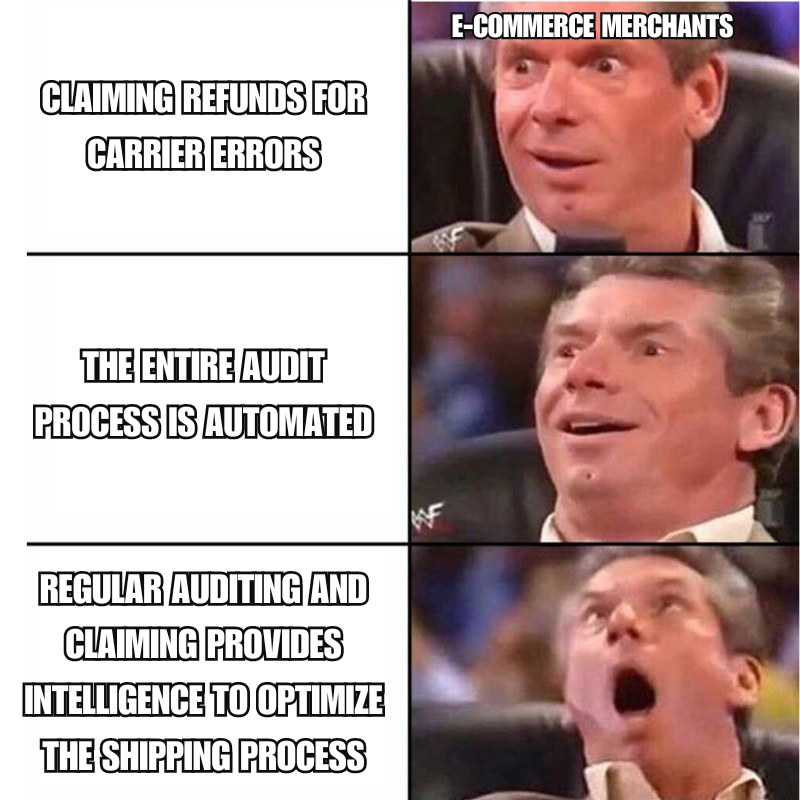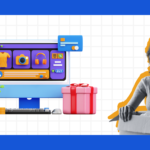Not just post-purchase or even e-commerce, but most blogs that you sit down to read, either in your leisure time or on the go — tell you two things. You can either do this or do not do this. How about something different for a bit? How about sitting and just looking at memes that perfectly describe the rollercoaster of emotions that you usually go through at your work?
Well, most work memes describe conditions at the workplace or a specific situation, like a customer coming in with a weird request. How about another change? Let’s talk about memes that capture what your customers (and maybe even you!) experience in the post-purchase — shipping, delivery, and returns phases as well as decode the process they represent.
Think of this article as putting down everything you’re doing to scroll through your social account and laugh at a video of the two cats talking to each other. For people working in the hectic area of e-commerce, especially in the post-purchase phase, we’d like to call this article the digital embodiment of TGIF.
Let’s start with the most relatable memes and progress to the most thought-provoking ones.
ICYMI, here’s the first part of this article — e-commerce memes that exclusively cover just the order delivery phase.
1. Estimated Delivery Date
Meeting customers’ high expectations regarding order deliveries might not be so easy but remember, there are a lot of brands out there that would easily replace you as their choice unless you’re making efforts to give them what they want.
To keep up with the rising competition, you need to constantly create an opportunity for the customer to trust your brand.
A great way to start your efforts is to set them with the right delivery expectations and show that a great post-purchase experience awaits them. You can do this by showing the estimated order arrival date on multiple areas of your website such as product, cart, and checkout pages.

Knowing the delivery timeline, keeps their expectations in check and helps you improve conversions and reduce cart abandonment. Just make sure to not break their trust.
2. Lack of Updates

A situation where all of us as customers would have definitely been at least once. That really speaks volumes about the relatability of this issue, we might say.
We place an order, it gets confirmed, we get ecstatic… Then what? We’d have to wait 2-3 business days until the package to be mysteriously delivered. This happens in most cases and should be highly avoided if you’re the merchant.
Because, here’s what happens — On average, 1 in 5 parcels shipped face delivery issues, such as delays and getting lost, and customers are aware of this — making them constantly worry that their package would be one of them. This puts them in a perpetual state of anxiety, causing them to bombard your support reps with WISMO inquiries, thereby consuming all of your support team’s time and leading to increased costs.
3. Issue Resolution

The post-purchase phase is notorious for issues that have the potential to hurt customer satisfaction if left unattended and when one such incident happens, all your efforts to provide the customer with a great shopping experience won’t matter if a subpar post-purchase experience is all your customers are going to remember about your brand.
You don’t have to do anything new or special. Just include proactive shipping notifications for events such as delays, lost in transit, failed delivery attempts, etc, and assure the customer that efforts are being made to rectify the issue at hand. This prevents customer frustration and thereby complaints and bad reviews.

With customers satisfied, you can follow up by sending a replacement or issuing coupons for upcoming purchases, whatever they prefer to exceed the expectations of your brand.
4. Complex Return Policies and Procedures
Everything went well with the delivery process and the customer is excited to open their package. But it was not what they expected — the order was of the wrong size or color, then there’s no choice for the customer but to return their purchase, the one that they’ve waited for all this time.

Contrary to the myths, returns are not a bad thing. In fact, they open doors for new CX opportunities in the post-purchase phase. But that doesn’t mean customers are excited to do returns each time, so make sure the experience isn’t even stressful for them.
Simplify returns for them with your policies and procedures:
- Make your return policy easily accessible on your website
- Clearly outline the return window, eligible items, refund options (full, partial, store credit), and any restocking fees
- Make initiating returns easy via a self-serve returns portal
- Allow returns to multiple locations (stores, drop-off points) or offer pick-up services
- Provide customers with real-time tracking information for their return shipment
- Just like delivery status notifications, send timely email updates on the status of the return and refund.
5. Customer Service Nightmares
Let’s assume a brand missed out on doing each of the aforementioned steps or even just one of them.
What do you think happens next?
All of your support reps’ time is wasted tending to customer queries and complaints, preventing other important stuff like product-related inquiries from getting addressed. This leads to additional costs in the form of unwanted support tickets.
Also, too many support inquiries to handle, results in slower response and first resolution times, and ultimately putting your customer in a state of outrage.

By making use of a real-time tracking solution like LateShipment.com’s Delivery Experience Management, you can provide support agents with order status info inside your helpdesk to enable fast resolution of delivery issues. Overtime, this enables a better control to measure and improve support operations and post-purchase CX with accuracy & speed.
6. High Shipping Costs
One of the major reasons behind cart abandonment is customers facing the shock of high shipping costs as they’re about to checkout (48%). When this becomes repetitive, you have no option but to absorb these costs, giving up a percent of your profit in return for conversions.
There’s a better way to do this with not one, but multiple solutions — explore regional fulfillment centers to shorten distances, offer BOPIS options, negotiate better rates with carriers, and offer transparent shipping options with clear cost breakdowns.
Additionally, you can consider offering free shipping and return shipping as a marketing tool to attract customers and boost conversion rates.

7. Benefits of Insuring Packages
Adding to increased shipping costs cometh the costs associated with order delivery issues such as lost and damaged incidents that are more frequent in occurrence than you think.
This is where shipping insurance comes in. If you’re an e-commerce merchant who regularly has to ship out parcels with expensive content, try getting them insured.
Shipping insurance gives you financial security against potential loss or damage and allows you to ship out parcels without worrying about significant losses due to said delivery issues. The best part, despite its numerous benefits, insurance is easier to get than most people think.

Especially with third-party, merchant-led insurance options like LateShipment.com — you can bring in comprehensive coverage options, automate insurance based on custom rules, and effortlessly manage claims.
8. Refunds for Carrier Errors
Apart from loss and damage, there exist over 50 carrier errors including delivery issues such as late deliveries and billing errors such as unwanted surcharges that go into your shipping invoices.
The issue? These costs (although smaller in isolation), are common and severe in the long run, adding an extra 20% or so on your shipping bills.
But as with all other problems mentioned above, we also have a solution for it. Start auditing your parcels and claim refunds for 50+ service failures and save on shipping costs.
However, it may not be easy as manually auditing all your shipping invoices is an exhaustive task. Thus, get your hands on automation to submit refund claims and recover every dollar that is rightfully yours.

9. Optimizing Shipping Processes
Regularly auditing your invoices and claiming refunds also shows you which areas of your shipping and delivery need improvement.
For example, what delivery issues or billing errors are a more common sighting, which carrier performs with the most inefficiencies, how much are you spending on shipping, etc.
All these insights can help you negotiate better carrier rates, make better shipping choices, and ultimately curate your most profitable shipping strategy.

10. Savings on Returns
Another great way to start saving on shipping costs is to reduce as many returns as you can.
One approach is to mention all return details correctly in your shipping policy, ensure products are of the highest quality, etc, and cut down on unwanted returns. Another approach is to make sure that not all returns are refunded but instead opportunities for repeat shopping.
For example, you can encourage customers to exchange and store credits over refunds to secure the sale and make customers shop with you again.

11. Post-Purchase Branding
You might think savings are the best thing to come out of your post-purchase.
But what if I told you there’s something better? And that is post-purchase being a revenue channel of its own when put to maximum use.
The first step towards that course is to replace traditional order tracking in carrier pages with custom-built branded tracking experiences.
For instance, populate the tracking pages built on your domain and shipping notifications with your branded elements such as color, font, etc, to keep customers in a brand-immersive experience and ensure your brand remains on the top of the customers’ minds.

12. Post-Purchase As A Marketing Channel
Customers track their order 6 to 8 times before delivery, that’s 6 to 8 lost opportunities to generate more sales during order tracking.
Once you’ve made sure your customers have had a positive experience and your brand recall game is done right, the next step is to transform tracking moments into recurring revenue opportunities with effective cross-sell techniques.
A great way to do that is to include personalized product recommendations, discounts, and other sales promotions on your tracking page and shipping notifications to double your chances at driving sales.

Final Word
So, there you have it – a glimpse into hilarious (and relatable) post-purchase memes. While laughter is certainly the best medicine, remember, these memes aren’t just for amusement. They hold valuable insights into your customers’ minds and experiences.
So embrace the meme, embrace the feedback, and keep creating an e-commerce experience that’s anything but meme-worthy (in a bad way, that is)!






